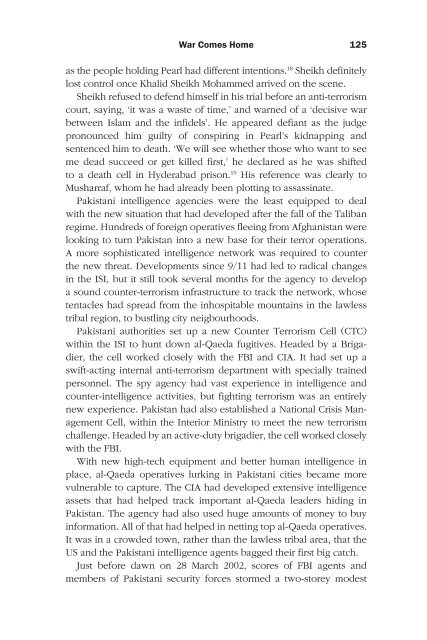Frontline Pakistan : The Struggle With Militant Islam - Arz-e-Pak
Frontline Pakistan : The Struggle With Militant Islam - Arz-e-Pak
Frontline Pakistan : The Struggle With Militant Islam - Arz-e-Pak
You also want an ePaper? Increase the reach of your titles
YUMPU automatically turns print PDFs into web optimized ePapers that Google loves.
War Comes Home<br />
as the people holding Pearl had different intentions. 18 Sheikh definitely<br />
lost control once Khalid Sheikh Mohammed arrived on the scene.<br />
Sheikh refused to defend himself in his trial before an anti-terrorism<br />
court, saying, ‘it was a waste of time,’ and warned of a ‘decisive war<br />
between <strong>Islam</strong> and the infidels’. He appeared defiant as the judge<br />
pronounced him guilty of conspiring in Pearl’s kidnapping and<br />
sentenced him to death. ‘We will see whether those who want to see<br />
me dead succeed or get killed first,’ he declared as he was shifted<br />
to a death cell in Hyderabad prison. 19 His reference was clearly to<br />
Musharraf, whom he had already been plotting to assassinate.<br />
<strong><strong>Pak</strong>istan</strong>i intelligence agencies were the least equipped to deal<br />
with the new situation that had developed after the fall of the Taliban<br />
regime. Hundreds of foreign operatives fleeing from Afghanistan were<br />
looking to turn <strong><strong>Pak</strong>istan</strong> into a new base for their terror operations.<br />
A more sophisticated intelligence network was required to counter<br />
the new threat. Developments since 9/11 had led to radical changes<br />
in the ISI, but it still took several months for the agency to develop<br />
a sound counter-terrorism infrastructure to track the network, whose<br />
tentacles had spread from the inhospitable mountains in the lawless<br />
tribal region, to bustling city neigbourhoods.<br />
<strong><strong>Pak</strong>istan</strong>i authorities set up a new Counter Terrorism Cell (CTC)<br />
within the ISI to hunt down al-Qaeda fugitives. Headed by a Brigadier,<br />
the cell worked closely with the FBI and CIA. It had set up a<br />
swift-acting internal anti-terrorism department with specially trained<br />
personnel. <strong>The</strong> spy agency had vast experience in intelligence and<br />
counter-intelligence activities, but fighting terrorism was an entirely<br />
new experience. <strong><strong>Pak</strong>istan</strong> had also established a National Crisis Management<br />
Cell, within the Interior Ministry to meet the new terrorism<br />
challenge. Headed by an active-duty brigadier, the cell worked closely<br />
with the FBI.<br />
<strong>With</strong> new high-tech equipment and better human intelligence in<br />
place, al-Qaeda operatives lurking in <strong><strong>Pak</strong>istan</strong>i cities became more<br />
vulnerable to capture. <strong>The</strong> CIA had developed extensive intelligence<br />
assets that had helped track important al-Qaeda leaders hiding in<br />
<strong><strong>Pak</strong>istan</strong>. <strong>The</strong> agency had also used huge amounts of money to buy<br />
information. All of that had helped in netting top al-Qaeda operatives.<br />
It was in a crowded town, rather than the lawless tribal area, that the<br />
US and the <strong><strong>Pak</strong>istan</strong>i intelligence agents bagged their first big catch.<br />
Just before dawn on 28 March 2002, scores of FBI agents and<br />
members of <strong><strong>Pak</strong>istan</strong>i security forces stormed a two-storey modest<br />
1













